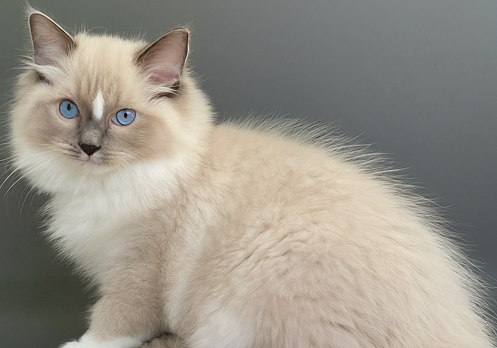For centuries, cats have captivated us with their grace, intelligence, and undeniable charm. But beyond their mesmerizing eyes and playful personalities lies a hidden world waiting to be explored – the world of feline fur. Cat coats come in a dazzling array of colors and patterns, each with its own unique name and story to tell. This comprehensive guide delves into the fascinating world of cat coat pattern names, empowering you to decipher the secret language hidden within your feline friend’s fur.

Unveiling the Magic: Understanding Cat Coat Genetics
Before we embark on our exploration of specific coat names, understanding the underlying genetics that govern feline fur is crucial. Cat coat colors and patterns are determined by a complex interplay of genes. Two primary genes, Agouti (A) and Melanocyte-stimulating hormone (MSH), play a dominant role. The Agouti gene dictates whether a cat has a banded (tabby) or solid coat. The MSH gene, on the other hand, influences the production and distribution of melanin, the pigment responsible for fur color. Variations within these genes, along with the presence of additional modifier genes, create the stunning diversity we observe in cat coats.
Key Genes Influencing Cat Coat Color and Pattern
| Gene | Function | Resulting Coat Characteristics |
|---|---|---|
| Agouti (A) | Dominant (A) – Banded (Tabby) coat | Recessive (aa) – Solid coat |
| Melanocyte-stimulating hormone (MSH) | Affects melanin production and distribution | Black, brown, cinnamon, fawn |
| Extension (E) | Dominant (E) – Full color expression | Recessive (ee) – Red (ginger) or cream dilution |
Additional Resources:
A Kaleidoscope of Colors: Exploring the Spectrum of Feline Fur
Now that we’ve unveiled the genetic code behind cat coats, let’s delve into the vibrant world of colors! Here’s a breakdown of the most common feline fur colors and their captivating names:
- Black: This classic and elegant color arises from an abundance of melanin in the cat’s fur. Black cats often have a sleek, shiny coat that shimmers in the light.
- White: Pure white cats possess minimal to no melanin in their fur. This immaculate coat can be accompanied by blue or odd-eyed features in certain breeds.download
- Red (Ginger): This fiery hue, exclusive to male cats (except in rare XXY chromosomal cases), results from a lack of the extension gene, allowing the expression of the red pigment pheomelanin. Red cats come in various shades, from vibrant orange to a softer apricot.download
- Cream: A diluted version of red, cream fur arises when both extension genes are recessive. This pale, buttery color often appears in bicoloured or tortoiseshell cats.download
- Brown: This rich, chocolatey color is a variation of black caused by a mutation in the MSH gene. Brown cats often have copper-flecked eyes, adding to their mesmerizing beauty.
- Cinnamon: A lighter and warmer variation of brown, cinnamon fur results from a further dilution of the MSH gene. These cats often have golden or green eyes.
- Fawn: The most diluted form of black, fawn fur appears as a light beige or sandy color. These cats frequently have green or hazel eyes.
- Blue (Grey): This seemingly blue coat is actually a dilution of black caused by a recessive modifier gene. Blue cats can range from a light, silvery shade to a deeper, smoky grey.
- Lilac: A further dilution of brown fur, lilac appears as a soft, dusty rose color. These cats often have amber or green eyes.
A Symphony of Stripes and Splotches: Unveiling Coat Patterns
Beyond the captivating colors, cat coats come alive with a mesmerizing array of patterns. Let’s explore the most common feline coat patterns and their intriguing names:
- Solid/Self: As the name suggests, solid coats showcase a single, uniform color throughout the body. This classic pattern is observed in cats of various colors, from sleek black to vibrant red.
- Tabby: This iconic pattern features distinctive stripes, swirls, or blotches on a solid-colored background
Unveiling the Magic of Tabby Cats: A Celebration of Stripes and Swirls
The tabby pattern, perhaps the most recognizable amongst cat coats, is a true testament to feline diversity. Within the world of tabbies lies a symphony of stripes and swirls, each with a unique name and story to tell. Let’s delve deeper into the captivating world of tabby patterns:
- Classic Tabby: This timeless design features bold stripes running down the body, along with a distinctive “M” marking on the forehead. Classic tabbies can further be classified into three sub-patterns:
- Brown Tabby: The most common tabby variation, featuring black or brown stripes on a brown or fawn background.
- Silver Tabby: This dazzling pattern showcases black stripes on a silvery-white background, creating a shimmering effect.
- Blue Tabby: A cooler version of the classic tabby, featuring grey stripes on a blue-grey background.
- Mackerel Tabby: This sleek pattern features vertical stripes running down the body, resembling the stripes of a mackerel fish. Mackerel tabbies often have a single stripe running down their spine and chevrons on their flanks.download
- Spotted Tabby: As the name implies, this playful pattern features distinct spots scattered across a solid-colored background. Spotted tabbies can be further categorized based on the shape and density of their spots:
- Classic Spotted Tabby: Features round spots on a solid background.
- Rosetted Tabby: This striking pattern showcases elongated spots with a central “bullseye” pattern, resembling miniature rosettes. Commonly seen in Bengal cats.
- Ticked Tabby: This unique pattern appears almost solid-colored at first glance. However, upon closer inspection, individual hairs are banded with alternating colors, creating a subtle “ticked” effect. This pattern is most prominent in Abyssinian and Burmese breeds.
Beyond the Basics: A Glimpse into Rare and Unique Coat Patterns
The world of cat coats extends far beyond the common varieties explored so far. Here’s a peek into some of the rarer and more captivating patterns:
- Bi-Color: This striking pattern features a white coat with patches of another color, such as black, red, or tabby markings. Bi-colored cats can be further categorized based on the extent of white markings:
- Harlequin: Characterized by large patches of color on a mostly white coat.
- Van Pattern: Features colored markings confined to the head and tail, with a white body.
- Bicolor with Mitts: This charming pattern showcases white markings on the paws, chest, and belly, with color adorning the head, back, and legs.
- Calico/Tortoiseshell: These captivating patterns are a result of X-chromosome inactivation in female cats. Calico cats exhibit a patchwork of black, red, and cream, while tortoiseshell cats showcase a blend of black and red without white markings.
- Colourpoint: This striking pattern features a lighter body coat with darker points on the face, ears, legs, and tail. Colourpoint is most commonly associated with Siamese and Ragdoll breeds.
- Smoke: This mesmerizing pattern features a solid-colored base with lighter underfur, creating a smoky veil effect when the cat moves. Smoke coats can be combined with other patterns, such as tabby or bi-color.
Decoding the Language of Fur: Understanding Breed-Specific Coat Variations
While the information above provides a general overview of cat coat colors and patterns, it’s important to remember that specific breeds often have unique fur characteristics. Here are some examples:
- Maine Coon: These gentle giants are known for their long, flowing fur that comes in a vast array of colors and patterns, including classic tabby, bi-color, and calico.
- Siamese: The quintessential colourpoint cat, Siamese cats possess a distinctive pointed pattern with a cream body and darker points in shades of seal brown, chocolate, or blue.
- Persian: This luxurious breed boasts a long, dense coat that can come in a dazzling array of colors, from solid white
The Allure of Genetics: Predicting Coat Colors and Patterns
Understanding the interplay of genetics behind cat coats can be fascinating, but predicting the exact color and pattern of a future feline friend can be tricky. Here’s a glimpse into the complexities of feline inheritance:
- Sex-Linked Traits: As mentioned earlier, the red (ginger) and tortoiseshell patterns are influenced by X-chromosome inactivation in females. Since males carry only one X chromosome, the red pigment gene is usually masked by the dominant black pigment gene on the other X chromosome in females. This explains why red cats are overwhelmingly male, while tortoiseshell and calico cats are almost exclusively female (except for rare XXY chromosomal cases).
- Polygenic Inheritance: Many cat coat colors and patterns are not determined by a single gene but rather by a combination of multiple genes, each contributing a small effect. This polygenic inheritance makes predicting the exact outcome in breeding pairs more challenging.
- Modifier Genes: The expression of primary color and pattern genes can be further influenced by the presence of additional modifier genes. These genes can affect the intensity of colors, distribution of markings, or even introduce entirely new patterns.
Despite the complexities, some general predictions can be made based on the parents’ coat characteristics:
- Solid Colored Parents: If both parents are solid colored, the kittens are likely to be solid colored as well, although tabby or other hidden patterns might emerge.
- Tabby Parents: When both parents exhibit tabby patterns, the kittens will likely inherit some form of tabby markings. The specific pattern (classic, mackerel, spotted) will depend on the specific genes carried by each parent.
- Bicolored Parents: Predicting the outcome in bicoloring breeding is more challenging due to the influence of polygenic inheritance. However, the likelihood of kittens inheriting the bicolor pattern increases if one or both parents possess it.
Remember, these are just general guidelines. The fascinating world of cat genetics often throws surprises, making every new litter a delightful discovery!
Beyond Aesthetics: The Functional Significance of Cat Coats
While cat coats come in a mesmerizing array of colors and patterns, these characteristics are not merely aesthetic. They can serve various functional purposes:
- Camouflage: Tabby markings with stripes and spots provide excellent camouflage in natural environments, allowing cats to stalk prey or avoid predators.
- Temperature Regulation: Double coats, common in breeds like Maine Coons and Persians, offer insulation in cold climates. Conversely, short, sleek coats found in Siamese cats help regulate body temperature in warmer environments.
- Communication: Cats use their fur patterns for communication. Raised fur on the back can signal aggression, while white markings on the face or paws might be used for social recognition.
The interplay of genetics, environment, and function has shaped the evolution of cat coats, creating a diverse and captivating world of feline beauty.
Conclusion
The world of cat coats is a captivating tapestry woven from genetics, evolution, and sheer beauty. From the classic elegance of a solid black to the playful charm of a spotted tabby, each cat’s fur tells a unique story. Understanding the language hidden within these varieties allows us to appreciate the feline form in its full glory. So the next time you gaze upon your furry companion, take a moment to admire the mesmerizing masterpiece adorning their body – a testament to the wonders of nature and the magic of cats.
FAQs
- What is the rarest cat coat color? There’s no single rarest color, but some like chocolate and lilac are less common. Additionally, specific patterns like rosetted tabbies or bi-color with specific markings can be rarer within certain breeds.
- Can the color of a cat’s coat change over time? Yes, kittens can sometimes darken or lighten in color as they mature. Additionally, sun exposure can cause slight lightening in some coat colors.
- Do cat coat colors and patterns affect personality? While there’s no scientific evidence of a direct link, some anecdotal observations associate certain coat colors with specific personality traits. However, individual personalities vary greatly within each color and pattern.
- How can I identify the specific coat color and pattern of my cat? Online resources and breed standards can provide guidance. Consulting a veterinarian or experienced breeder can also help with identification.
Additional Resources for Delving Deeper into the Feline Fur Cosmos:
- Cat Fancier’s Association (CFA) – Breed Standards: The CFA website provides detailed breed standards for various recognized cat breeds, including descriptions of expected coat colors and patterns for each breed. This can be a valuable resource for identifying your cat’s specific coat characteristics. https://cfa.org/wp-content/uploads/2019/07/19-20standards.pdf
- The International Cat Association (TICA) – Breed Standards: Similar to the CFA, TICA’s website offers breed standards outlining expected coat characteristics for various cat breeds. Consulting both CFA and TICA standards can provide a comprehensive picture of breed-specific coat variations. https://www.tica.org/resources/our-publications/breed-standards
- Online Cat Coat Color and Pattern Identification Guides: Numerous websites and forums cater to cat enthusiasts and offer interactive guides to help identify cat coat colors and patterns. These guides often include high-quality reference pictures for comparison.
- Veterinarian Consultation: If you’re unsure about your cat’s coat color or pattern, consulting a veterinarian can be a helpful option. Veterinarians are familiar with various feline coat characteristics and can provide guidance based on their examination of your cat.
- Cat Genetics Websites and Forums: Delve deeper into the fascinating world of feline genetics! Websites and forums dedicated to cat genetics explore the science behind coat color and pattern inheritance. These resources can provide a deeper understanding of the complex mechanisms at play.
Remember, the world of cat coats is a vast and ever-evolving realm. New discoveries and genetic variations are continually being documented. Stay curious, explore the resources listed above, and continue to appreciate the captivating beauty of your feline friend’s unique fur!






